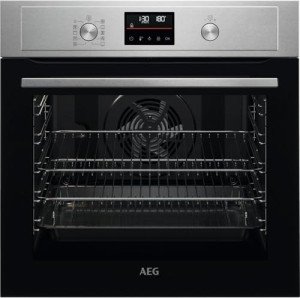Responsible For An Self Cleaning Oven Technology Budget? 10 Unfortunate Ways To Spend Your Money

Understanding Self-Cleaning Oven Technology: A Comprehensive Guide
Cooking can frequently lead to a messy kitchen, and ovens are infamous for gathering spills, leaks, and burnt-on food. Conventional cleaning techniques can be labor-intensive and time-consuming, which is why self-cleaning ovens have ended up being a popular option. Cheap Self Cleaning Ovens explores the technology behind self-cleaning ovens, the different types offered, how they work, their benefits and disadvantages, and responses to frequently asked questions.
What is Self-Cleaning Oven Technology?
Self-cleaning ovens are kitchen area home appliances particularly created to clean themselves through high heat or particular cleaning modes. The primary purpose of this technology is to streamline the upkeep of an oven while ensuring it runs efficiently and securely.
Types of Self-Cleaning Ovens
There are mostly two main kinds of self-cleaning ovens: Pyrolytic Cleaning and Steam Cleaning. Each type uses a different technique to achieve tidiness.
| Type | Description | Benefits | Downsides |
|---|---|---|---|
| Pyrolytic | Uses heats (around 900 ° F or 482 ° C) to incinerate food splatters, turning them into ash. | Extremely reliable; needs minimal effort. | High energy use; some models can be noisy. |
| Steam | Employs steam to loosen up and soften grime for simpler removal. | Lower temperatures utilized; normally quieter. | May need manual scrubbing later. |
How Does Self-Cleaning Oven Technology Work?
Pyrolytic Cleaning Process
When utilizing the pyrolytic cleaning cycle, the oven raises its temperature to around 900 ° F. Here's how the process generally unfolds:
- Preparation: Remove oven racks and any other items inside.
- Temperature Rise: The oven instantly increases its temperature to the set pyrolytic temperature level.
- Burn-off Phase: At high temperature levels, natural product like grease and food residues combust, becoming ash.
- Cooling Down: After the cycle, the oven cools off, and the ash can be quickly wiped away after the oven has actually cooled.
Steam Cleaning Process
With the steam cleaning method, the process is less severe:
- Preparation: Similar to pyrolytic cleaning, the oven must be emptied.
- Water Addition: Water is added to a designated tank or tray within the oven.
- Steam Generation: The oven is warmed for a much shorter period, enabling the steam to permeate and loosen up baked-on food.
- Wipe Clean: Once the cycle is total, the user can simply clean away the loosened particles with a fabric.
Advantages of Self-Cleaning Ovens
Self-cleaning ovens offer several benefits that can interest busy householders and cooking enthusiasts alike:
- Time-Saving: Automating the cleaning process enables users to take part in other jobs instead of scrubbing.
- Efficiency: The high temperature levels used in pyrolytic cleaning get rid of bacteria and germs, ensuring much safer cooking.
- Convenience: With very little manual intervention required, self-cleaning ovens streamline kitchen maintenance.
Drawbacks of Self-Cleaning Ovens
Regardless of their benefits, self-cleaning ovens likewise have some downsides:
- Energy Consumption: Pyrolytic cleaning processes can significantly increase energy costs due to high energy usage.
- Odor and Smell: The high temperatures used in pyrolytic cleaning can produce undesirable smells throughout the cycle.
- Safety Concerns: The intense heat can present risks, particularly in homes with children or family pets, necessitating additional precaution.
- Minimal Usability: Self-cleaning cycles can take numerous hours, making the oven unavailable for cooking throughout that time.
Self-Cleaning Oven Care Tips
To make sure the durability and effectiveness of a self-cleaning oven, think about the following tips:
- Regular Maintenance: Regularly wipe down the interior with a damp fabric to get ready for the next cleaning cycle.
- Follow Instructions: Always adhere to maker guidelines concerning cleaning cycles and maintenance.
- Get Rid Of Accessible Parts: Take out racks and any non-self-cleanable parts before starting the cleaning process.
- Screen Heating: Be aware of temperature level settings and prevent using the self-clean mode exceedingly.
FAQs About Self-Cleaning Ovens
1. Is it safe to leave my self-cleaning oven unattended throughout the cleaning cycle?
While many contemporary ovens are geared up with safety features, it's recommended to stay nearby throughout the cleaning cycle, especially during the preliminary usages.
2. How often should I utilize the self-cleaning feature?
It's suggested to utilize the self-cleaning function roughly when every couple of months or as needed, depending upon usage and buildup.
3. Will the self-cleaning cycle damage my oven?
A lot of ovens are designed to withstand the high temperatures of the self-cleaning cycle. Following the maker's instructions assists avoid damage.
4. Can I use cleaning products throughout self-cleaning?
No, it's best not to utilize any extra cleaning products or chemicals during the self-cleaning cycle, as they can create harmful fumes.
5. What occurs to the ash after pyrolytic cleaning?
After the pyrolytic cleaning cycle, users must erase the ash left in the oven after it cools off.
Self-cleaning oven technology is a remarkable development that significantly relieves the concern of kitchen maintenance, bringing efficiency and convenience to home cooking. Comprehending the kinds of self-cleaning methods and their functionality can assist users select the best design for their requirements, ensuring a cleaner and more satisfying cooking environment. With the ideal care, self-cleaning ovens can remain a trusted tool in any kitchen for years to come.

